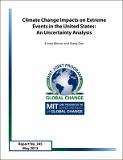| dc.description.abstract | Extreme weather and climate events, such as heat waves, droughts and severe precipitation events, have substantial impacts on ecosystems and the economy. However, future climate simulations display large uncertainty in mean changes. As a result, the uncertainty in future changes of extreme events, especially at the local and national level, is large. In this study, we analyze changes in extreme events over the US in a 60-member ensemble simulation of the 21st century with the Massachusetts Institute of Technology (MIT) Integrated Global System Model–Community Atmosphere Model (IGSM-CAM). Four values of climate sensitivity, three emissions scenarios and five initial conditions are considered. The results show a general intensification of extreme daily maximum temperatures and extreme precipitation events over most of the US. The number of rain days per year increases over the Great Plains but decreases in the northern Pacific Coast and along the Gulf Coast. Extreme daily minimum temperatures increase, especially over the northern parts of the US. As a result, the number of frost days per year decreases over the entire US and the frost-free zone expands northward. This study displays a wide range of future changes in extreme events in the US, even simulated by a single climate model. Nonetheless, it clearly shows that under a reference emissions scenario with no climate policy, changes in extreme events reach dangerous levels, especially for large values of climate sensitivity. On the other hand, the implementation of a stabilization scenario drastically reduces the changes in extremes, even for the highest climate sensitivity considered. | en_US |
